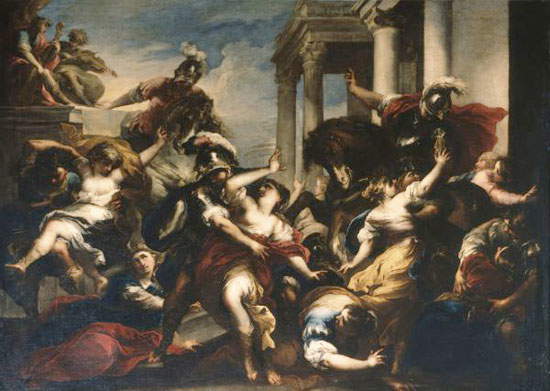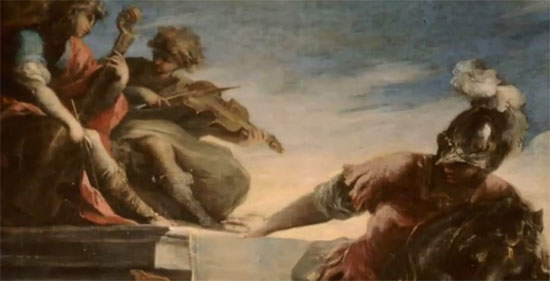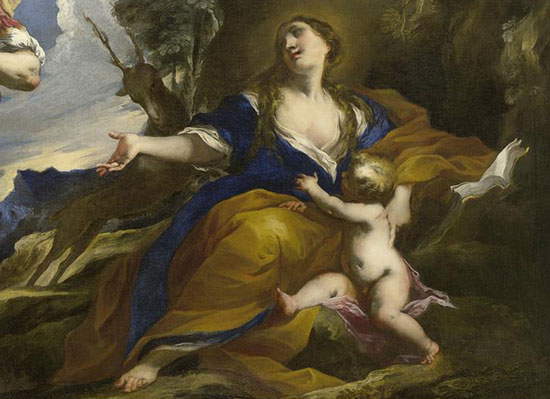In 2008, a major monographic exhibition dedicated to Valerio Castello ( Genoa, 1624 - 1659), the greatest genius of the Genoese Baroque (and the exhibition was in fact titled Valerio Castello 1624 - 1659. Modern Genius). On that occasion, an interesting documentary was produced, lasting just under twenty minutes, with texts written by one of the curators of the exhibition, Camillo Manzitti, among the leading experts on seventeenth-century Genoese art. The video, which can also be found on major video-sharing portals (we offer it below), traced in broad strokes the life and career of Valerio Castello, dwelling on the main suggestions that the artist received in the context of his production.
One of the most recognizable suggestions is that exerted by melodrama, the musical genre that was beginning to spread precisely in the first decades of the seventeenth century: given the success that melodrama enjoyed somewhat throughout Italy, it is fair to imagine that there were not a few painters capable of allowing themselves to be attracted by the charm of works set to music. These painters included Valerio Castello himself: with the help of the documentary (from which we have taken the excerpts that follow in italics) we therefore want to analyze a couple of his works to see, up close, how melodrama had also entered his art.
With reference to Valerio Castello, the document begins, in the section devoted to melodrama, by letting us know that there is no doubt that in many of the works of his maturity, one must recognize the reflections of what represented the great novelty of that time in the artistic field: the extraordinary affirmation of melodrama, with the consequent profound influence it exerted on the customs of the society of the time through spectacular performances, which were given with great success in the theaters (in Genoa, in that of the Falcone) for the first time open to a paying public that flocked in large numbers and enthusiastically. Genoa was, by the way, the first city in Italy, after Venice, to have its own theater open to the public with paying performances: the record belonged to the Teatro di San Cassiano in Venice, which achieved it in 1637 by opening to a ticketed audience the performance of Benedetto Ferrari and Francesco Manelli’sAndromeda. Genoa’s Teatro del Falcone, so called because the design was traditionally attributed to the architect Giovanni Angelo Falcone (but there are those who advance the hypothesis that the designer of the project was the Bolognese Andrea Sighizzi), was built on behalf of the Adorno family: in 1602 one of its members, Gabriele Adorno, had purchased a tavern on today’s Via Balbi with the specific intention of making it a theater. The latter opened its doors in 1652, with the performance of the first paid play: the Dido by the Florentine Vincenzo Della Rena.
We can safely imagine that Valerio Castello was also in the audience of that performance: in fact, his paintings from the 1950s appear dense with references to music and dance. In fact, the documentary goes on to tell us that it seems quite natural that the musical sentiment that had come to profoundly impregnate society’s tastes should be translated into painting by drawing on the properly aesthetic expression of that new art form: dance, understood as a set of movements and gestures regulated by an ideal rhythm, and tending, in their measured cadence, to poetic expression. Thus are born such absolute masterpieces as his [Valerio Castello’s] Rats of the Sabine Women, where the painter provides in a totally licentious manner, with respect to the tragic nature of an event in which the Sabine women are violently taken from the affection of their loved ones (parents, husbands and children), to insert in the composition improbable figures of orchestral musicians, following the sound of whose instruments the protagonists adapt their whirling twists to the rhythmic cadence of stylized dance steps. As is well known, the theme of the Rape of the Sabine Women was particularly popular with painters of the Baroque era, as it gave artists an opportunity to grapple with contorted poses, convulsive and sudden movements, pathos and drama for compositions in which the violence of the action was often diluted in a sumptuous theatricality: it also happens, as the documentary notes, in the Rape that Valerio Castello painted around 1653. A work in which the Sabine women do not seem, moreover, bothered by the inappropriate attentions of the Romans, but rather seem to abandon themselves with provocative lasciviousness in the arms of their captors. Valerio Castello’s work, which is now housed in a private collection, was once part of the collections of a Genoese nobleman, Francesco Donghi, and decorated a room in his palace in the Genoese contrada of Canneto, in the heart of the historic center.
 |
| Valerio Castello, Rape of the Sabine Women (c. 1653; oil on canvas, 145 x 203 cm; private collection) |
 |
| Valerio Castello, Rape of the Sabine Women, detail with orchestral musicians |
The influence of theatrical performances on Valerio Castello’s painting (influences that, according to Camillo Manzitti, would be entirely evident) can also be seen in other works. Continuing with the documentary: in the beautiful painting illustrating the Legend of Saint Geneviève of Brabant, now in Hartford, the action is expressed in a refined dance of courtship and figurative love, with all its stereotypical bows, the mimicry of playful attitudes, and the theatricality of reticent gestures that seem to evoke the elegant and carefree atmosphere of the minuet. The character of Saint Genevieve, a figure with legendary contours, had been made famous by Jacopo da Varazze’s Golden Legend, which described her as a noblewoman from Brabant, a historical region straddling Belgium and Holland. The woman was the wife of a local lord, Siegfried, who had to be absent from the palace for some time: Genovefa, a chaste and pious woman, would therefore be circumvented by a seducer, to whom, however, she would not succumb, and would therefore be accused, out of spite, of adultery. The woman would be sentenced to death along with her infant son: however, the servant in charge of carrying out the sentence would prefer to abandon her in a forest, and after some time Genoveffa would be found by her husband. Valerius Castello depicts precisely the moment when Siegfried, during a hunting trip (we see him richly dressed as a Roman soldier, albeit with a seventeenth-century feathered cap, while holding a spear and being followed by two dogs and some servants), finds his wife and son with, by his side, the doe that would allow the two to survive by feeding them with her own milk. The story, which mixes the sacred and the profane (and here the sacred aspect is highlighted above all by the group of little angels on the upper right) could not fail to provide Valerio Castello with the pretext for giving his painting all the theatricality that is well suited to the episode and that transpires from the gestures of the protagonists, from their “stereotyped” poses, from the play of glances that is established between the protagonists, between the movements of limbs and bodies that seem to follow the rhythm of music. Movements that, moreover, also seem to be indulged by the natural elements: the cave within which Genoveffa has found shelter seems almost to highlight with a circle the arrival of the saviors, and around this circle are also arranged the clouds, the mountains, the trees and even the doe.
 |
| Valerius Castello, Legend of Saint Genevieve (c. 1652; oil on canvas, 171 x 270 cm; Hartford, Wadsworth Atheneum Museum of Art) |
 |
| Valerio Castello, Legend of Saint Genevieve, detail with Saint Genevieve |
Valerio Castello’s mature works take on additional elements that prove that the Genoese artist’s production was fully in line with the typically Baroque concept of the total work of art, according to which the various art forms were to unite, add up, and influence each other: paintings that by decorating the walls of palaces suggested the illusion of standing before sculptures and architecture, statues that through the use of polychrome materials sought the pictorial effect, architectures that attempted to engage the viewer with daring effects, moreover establishing deep relationships with their surroundings. Valerio Castello, who had already demonstrated his typically Baroque mastery in easel works and in sumptuous frescoes that were fully influenced by the taste of his time, had added a musical component to his works of art: his more mature paintings therefore show themselves to the viewer as if they had been made to the notes of refined melodrama music.
Reference bibliography
Warning: the translation into English of the original Italian article was created using automatic tools. We undertake to review all articles, but we do not guarantee the total absence of inaccuracies in the translation due to the program. You can find the original by clicking on the ITA button. If you find any mistake,please contact us.